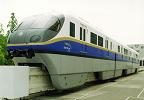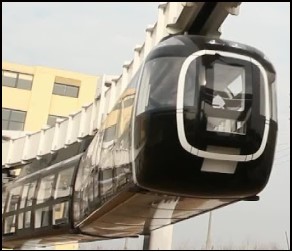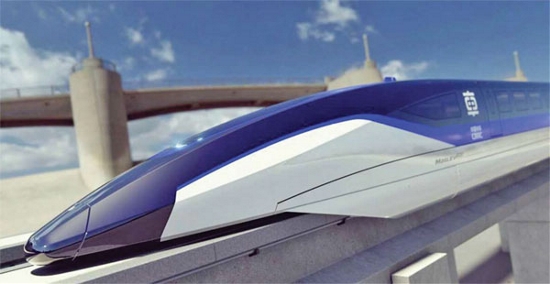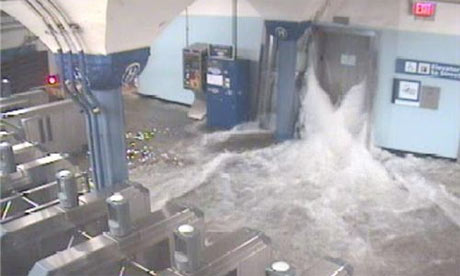Monorails as a Cost-Effective Transit Solution
|
*Approximate price for medium-sized walk-through straddle-beam monorail systems with stations every few kilometre and no large spans or tunnels based on overseas experience. |
Australia's congested major cities have no space left at ground level for new public transport and rail subway systems are very expensive.
High-capacity Monorails provide a safe, proven and cost-effective way to add extra public transport capacity.
Monorails leave space at ground level for people, cars and existing infrastructure. They can augment existing buses, trams, trains and ferries and create new links in the public transport network.
As well as expanding the whole public transport network Monorails can relieve the rail network of some inner city stops allowing rail express services to better service the outer suburbs and regional centres.
High Capacity Monorails
- Urban Monorails Large straddle-beam 'ALWEG' monorails have a capacity close to heavy rail systems with service frequencies of under two minutes. They are ideal as urban transit in our congested cities.
- High-Speed Monorails Maglev monorails are ideal for high-speed intercity transit at up to 500km/h.
Low Capacity 'Theme Park' Monorails
These include the former Sydney tourist monorail, the Sea world theme park monorail and the Oasis-Jupiter monorail.
None of these allow passenger walk-through so are inadequate for serious public transport applications so are not recommended by us.
Presentations
Why add a Monorail?
|
Watch the Bombardier Innovia 300 promotional video. (vimeo.com/65368766) |
- Monorails are independent. A new monorail system would be completely independent of existing transport modes and so unaffected by problems on other networks.
- Monorails are cost effective. Retrofitting a subway to a crowded city is usually prohibitively expensive. Great uncertainties usually exist as to the full cost of dealing with the myriad underground services (sewers, storm water, mains water, electricity & gas.) as well as geological challenges such as rock and mud. Often subway systems are below sea-level creating many expensive challenges during construction and maintenance. A high-capacity dual-beam Monorail system costs less than 10% per km as much as a two-track subway.
- Monorails are proven. Many monorail systems are in use as high-capacity public transport systems carrying thousands of passengers a day at up to 80 km/h. The Tokyo-Haneda monorail transports over three hundred thousand people per day on 500 train services.
- Monorails are safe. Being totally grade-separated monorails are one of the safest forms of transport. All the monorails advocated here allow passengers to move along the train and be evacuated to another monorail train. In almost all cases rescue from a monorail will be easier than rescue from a subway.
- Monorails don't flood. Subway systems are typically below sea-level and so subject to flooding in serious weather events.
- Monorails can be automated. Monorails can easily be automated allowing them to affordably run 7 days a week for 22 hours per day. Two hours is sufficient for guide way maintenance tasks. (We recommend an attendant be placed on most services to provide customer service, security and to ensure safe door closure.)
- Monorails are environmentally friendly. As well as having the energy-efficiency of other mass-transit systems, monorails are far less energy-intensive to build than a subway while having a much lower footprint than surface rail. Monorails can be installed with a minimum of disruption on the ground. Monorails have a lower visual impact than other types of elevated rail systems. Monorails don't stop at traffic lights providing an excellent alternative to cars in crowded cities.
- Reduced visual impact. Monorails have the least visual impact of any high-capacity elevated transit system.
- More Express Rail Services. As well as expanding the whole public transport network Monorails can relieve the rail network of some inner city stops allowing rail express services to better service the outer suburbs and regional centres.
- The High-Speed Rail Solution. Transrapid Maglev can provide a rapid transit system where speeds between 100 and 500 km/h are needed with a minimum of expensive tunnelling.
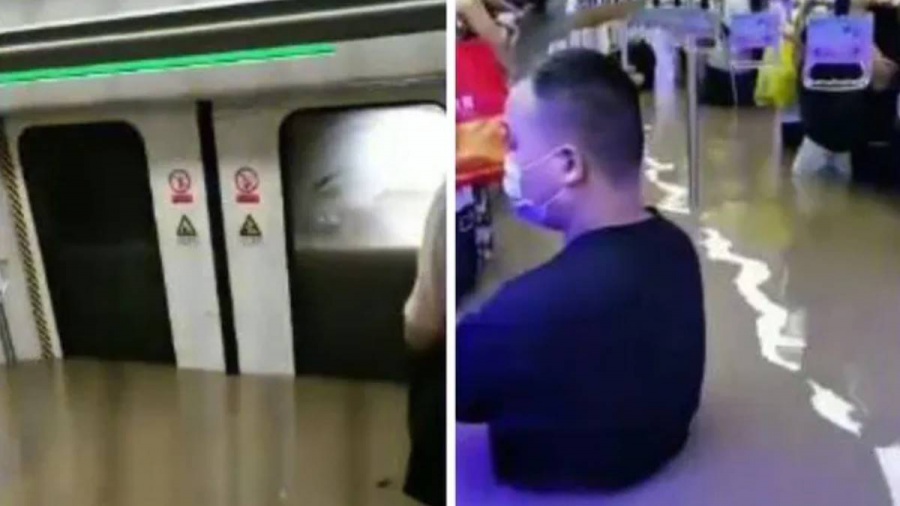 Flooding of the Zhengzhou subway in July 2021 |
Why not add a Monorail?
There are also good reasons to not use a monorail:
- An easement is available: There is no point building a monorail or a subway if a ground level grade-separated easement is available...unless you expect flooding, or want the easement for parkland, or housing, etc.
- There's no traffic congestion: The roads in the area are not crowded. In this case buses or trams could be used instead.
- Lots of stops are needed: Stops are needed every few hundred meters. This probably means a monorail would not be economic due to the cost of building all the stations unless they could all be hosted in existing buildings.
- No space above ground: In this case a subway would be the only alternative left.
- Government subway costing's are wrong: Some believe the Government estimates of rail subway construction such as those for the $9 billion nine kilometre Footscray - Caulfield Metro are completely wrong and the actual cost is 80 to 90% lower than stated. If subway systems really are cheaper than monorails per passenger per kilometre then subway systems should be built instead.
- Open technology licence cannot be obtained: An open licence to use the selected monorail technology within Australia cannot be obtained from the current patent-holder for a reasonable price. Monorail systems suffer from the lack of an open un-patentable standard so it is essential that Australian governments do not lock themselves into a particular manufacturer or patent-holder indefinitely. This is particularly crucial for Maglev monorails.
Why not add Bus Rapid Transit?
Bus Rapid Transit (BRT) is a good low-cost option where space is available on the roads that can be dedicated to the buses. Traffic lights must strongly favour the BRT. In this case BRT can offer a public transport solution at a much lower price than monorail, light rail or rail.
However, if the roads are already grid-locked it would take a very courageous politician to take road-space away from the car-addicted voters!Why not add more Light Rail?
Light Rail Transit (LRT) is more expensive and less flexible than BRT but generally has a higher capacity. Like BRT an absolute requirement for LRT is to have a dedicated easement and priority at all traffic lights.
Melbourne has a fantastic tram network but tram average speed is now 16 km/h and falling while 17% of the time trams are stopped at traffic lights.
Monorails vs. Trams and Trains.pdf.
|
Average tram speeds are in decline in Melbourne. Age Article. |
What is a Monorail?
The Monorail Society defines a monorail as:
| "A single rail serving as a track for passenger or freight vehicles. In most cases rail is elevated, but monorails can also run at grade, below grade or in subway tunnels. Vehicles are either suspended from or straddle a narrow guide way. Monorail vehicles are WIDER than the guide way that supports them." |
Urban Monorails
We advocate monorails for urban transit where no surface easement exists. High-capacity monorails can carry over 100 persons per carriage with operating speeds of up to 80km/h.
We only recommend monorails that allow free movement of passengers between the carriages. This is for safety reasons and to facilitate passenger movement. This excludes the small 'theme park' monorails like the old Sydney monorail.
Monorails vs. Trams and Trains.pdf.
Existing high-capacity urban monorails
An incomplete list of high-capacity monorail systems with currently available patronage numbers or estimates.
| System | Inception | Type | Length (km) | Patronage / Capacity |
| Tokyo-Haneda Airport (Hitachi) | 1964 | ALWEG | 17.8 | 120,000 per day |
| Shonan (Mitsubishi) | 1970 | SAFEGE | 6.6 | 30,000 per day |
| Kitakyushu, Japan (Hitachi) | 1985 | ALWEG | 8.8 | 31,700 per day |
| Chiba (Mitsubishi) | 1988 | SAFEGE | 15.5 | 45,000 per day |
| Osaka, Japan (Hitachi) | 1990 | ALWEG | 28 | 100,000 per day |
| Tama, Japan (Hitachi) | 1998 | ALWEG | 16 | 92,700 per day |
| Naha, Okinawa, Japan (Hitachi) | 2003 | ALWEG | 12.8 | 35,000 per day |
| Kuala Lumpur, Malaysia (Monorail Malaysia) | 2003 | ALWEG | 8.6 | 45,000 per day |
| Palm Jumeirah, United Arab Emirates (Hitachi) | 2003 | ALWEG | 5.4 | 40,000 per day |
| Las Vegas Monorail, Nevada (Bombardier) | 2004 | ALWEG | 6.3 | 30,000 per day |
| Chongqing Monorail (Hitachi) (More images) | 2005 | ALWEG | 74.6 | 30,000 per hour |
| Mumbai, India (Scomi) | 2014 | ALWEG | 20 | 125,000 per day* |
| São Paulo, Brazil Lion 15 (Bombardier) | 2014 | ALWEG | 26 | 48,000 PPHPD* |
| Daegu, South Korea (Hitachi) | 2015 | ALWEG | 24 | N/A |
*Estimated rider-ship or capacity for systems under construction. (PPHPD = passengers per hour per direction.)
Japan has led the way with using monorails to service congested urban areas. More and more cities are now turning to monorails to solve their transit problems.
ALWEG Straddle Beam Monorails
At around 10% of the cost of underground rail subway these high-capacity monorails should be considered for Australian cities.
|
Google street view
Street view of Kitakyushu Monorail, Japan. |
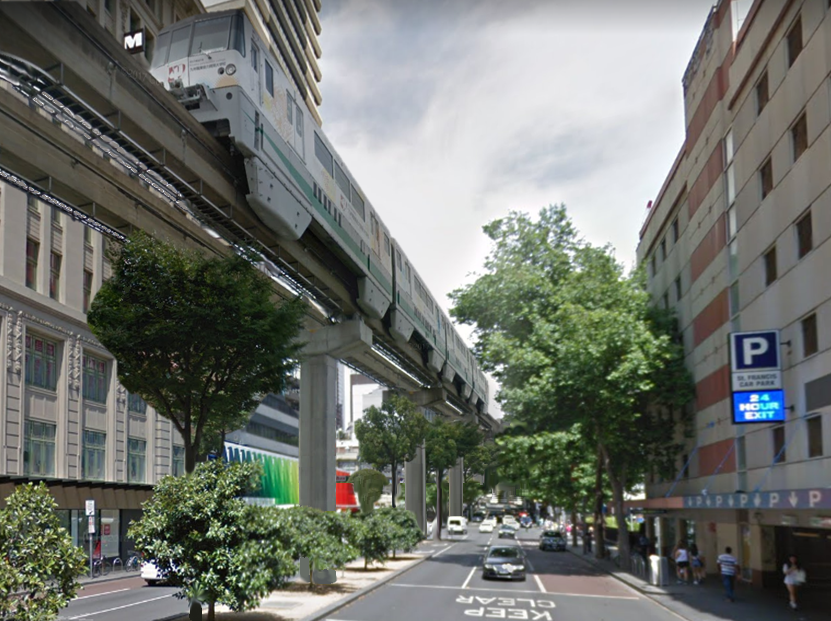 Elevated Metro 2 - Lonsdale Street, Melbourne? |
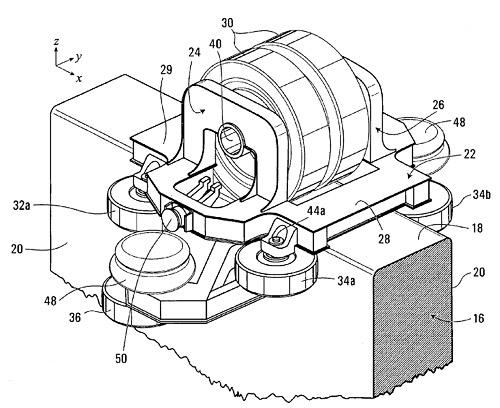
This diagram of the Bombardier Innovia bogie shows how the dual rubber tyres (30) roll on the beam (16) guided by six smaller horizontal tyres (32, 34 and 36). The bogie wheels are under the floor as shown in images on this page. (See also The Monorail Society - ALWEG pages.)
 Shadowing from ALWEG monorail beams.
Shadowing from ALWEG monorail beams. |
 Shadowing from an elevated conventional rail system.
Shadowing from an elevated conventional rail system. |
SAFEGE Suspended Monorails
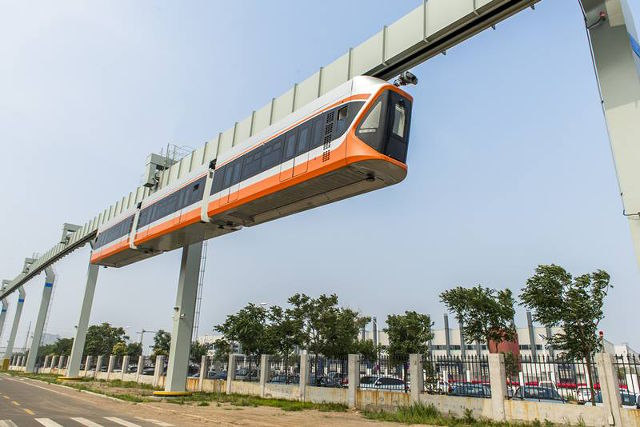 The CRRC Suspended Monorail follows the French SAFEGE design with the twist that it uses rechargable batteries instead of mains power in the gude-way. |
The SAFEGE design has advantages in extreme weather such as snow, hail, heavy rain or extreme heat since the track is fully enclosed and the vehicle is protected by the beam. SAFEGE monorails are more suited to hanging above roads which do not have a median strip. Unlike ALWEG monorails SAFEGE monorails automatically bank when cornering improving ride quality. (Effectively it is a Tilting Train).
Trains can have multiple carriages and like ALWEG monorails the track can negotiate tight bends and steep gradients. Currently CRRC, Morton and Mitsubishi have a SAFEGE product.
Urban Monorail Costs
Local factors such as labour costs and the need (in Japan) to be earthquake-resistant result in different prices for similar systems. Frequent stations also drives up the cost. In general shorter systems cost more per kilometre.
The Monorail Society has a guide to Monorail Cost. Note that these costs include all vehicles and maintenance facilities - which makes shorter systems more expensive per kilometre.
Rail Costs
- Melbourne Metro Rail Subway: ~$A 1,000 million / km. (Estimate of proposed heavy rail subway.)
- Melbourne Regional Rail Link: $A 93 million / km. (Actual cost of surface rail project.)
- Melbourne 'Skyrail': $A 200 million / km. ($1.6 billion for 8.2 km of elevated rail. Age Article.)
Urban Monorail Proposals
- Melbourne Skyrail Proposal. Overview of Melbourne 'Skyrail' monorail idea.
- Sydney City Monorail Proposals. These monorails would ease the overcrowding on CityRail.
- Perth Urban Monorail Proposal. An alternative the proposed Metro Area Express light rail system.
High-Speed Maglev Monorails
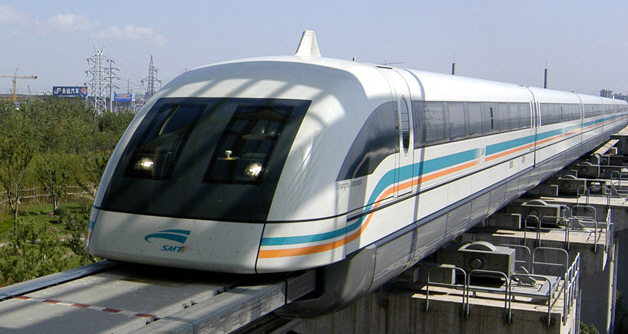
Transrapid Maglev Monorails are ideal where speeds between 100 and 500 km/h are required. (Image: Shanghai Transrapid Maglev) |
Instead of wheels, Maglev Monorails use magnets to glide above the track. The track itself propels the Maglev train over the track at speeds of up to 500 km/h.
Because there is no contact between the guide-way and the train is virtually silent up to 250 km/h.
Maglev's ability to handle tight curves and steep gradients makes it easier to fit above existing motorway easements rather than having to create new rail corridors. This helps avoid the need for expensive tunnelling and solves the problem of how to thread high-speed services past existing passenger and freight rail services.
- Maglev Overview. Details of the Transrapid Maglev system.
- Melbourne-Geelong maglev proposal. Melbourne to Geelong in 12 minutes with a stop at Avalon Airport.
- Melbourne airport maglev proposal. Melbourne to the airport in 8 minutes.
- Melbourne-Sydney maglev proposal. Melbourne to Sydney in two hours.
- Sydney-Newcastle maglev monorail proposal. Sydney - Newcastle in 25 minutes.
Before this technology could be used the relevant government would need to negotiate to obtain an open licence to use the Transrapid technology within Australia. This would allow sourcing of new vehicles, track and components from a variety of manufacturers in the future.
Monorail Myths & Misconceptions
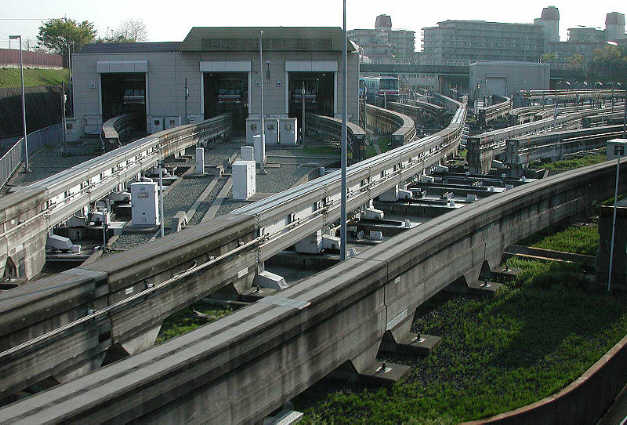
Switches at the storage facility of Osaka Monorail. (Monorail Society). |
- Monorails switches are a problem. One of the more persistent myths about monorails is that there is a problem with switches. In reality all commuter transit monorails use switches as much as conventional rail systems. Sections of the support beam move in seconds to effect the track switch. For more on ALWEG and SAFEGE monorail switches including videos see The Monorail Societies Switch Myth page.
- Monorails can't run at ground level. The above picture shows a monorail running just above ground level. The whole point of a monorail is that there is no space for a ground level transit system.
- With Monorails you can't have level crossings. Surely the dumbest of dumb criticisms! Monorails are built so you don't have any level crossings.
- Monorails can't go through tunnels. Many monorails run through tunnels for part of their length due to the difficult terrain. The Tokyo monorail used to run through a tunnel under a runway. Chongqing Monorail has several tunnels with underground stations.
- Monorails are not standardized. This means care needs to be taken to avoid being locked into one manufacturer's product indefinitely. In reality these Monorails are not that high-tech and a wide range of manufacturers could build new monorail carriages to fit on any particular track.
- Monorails are slow. 80 km/h is suitable for an urban transit system. If you need fast then High-speed maglev monorails can run at any speed up to 500 km/h.
- Monorails are low capacity. Large Hitachi monorails carry 900 passengers in a six-car train. The Tokyo monorail has carried millions of commuters for decades.
- Monorails cannot be used as they have been in a Simpson's Episode! Even worse Godzilla regularly trashes the Tokyo monorail. However, back in the real world the cost difference between monorail and subway construction still carries some weight. (But incredibly the most frequent criticism of monorails still reference the Marg vs. the Monorail episode.)

